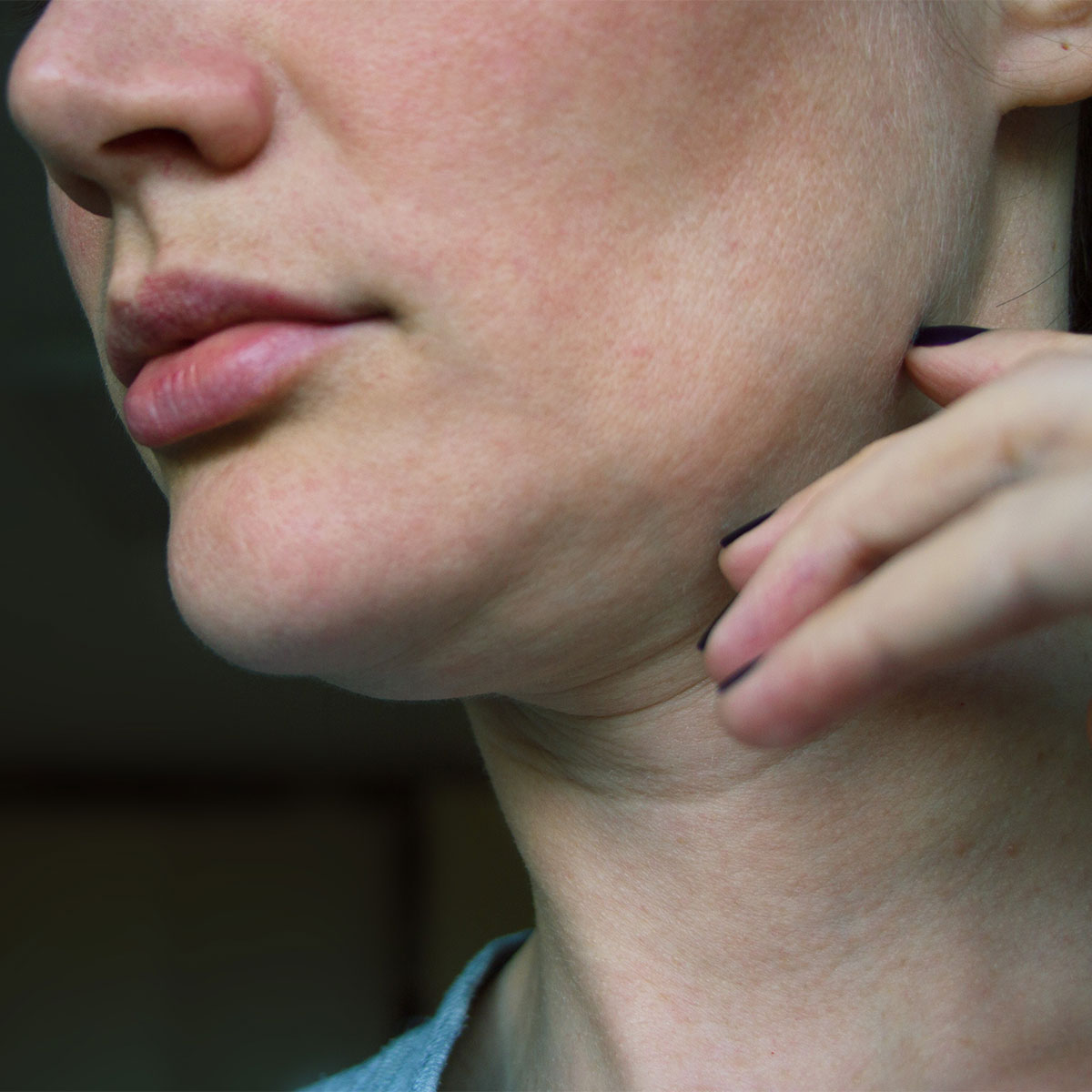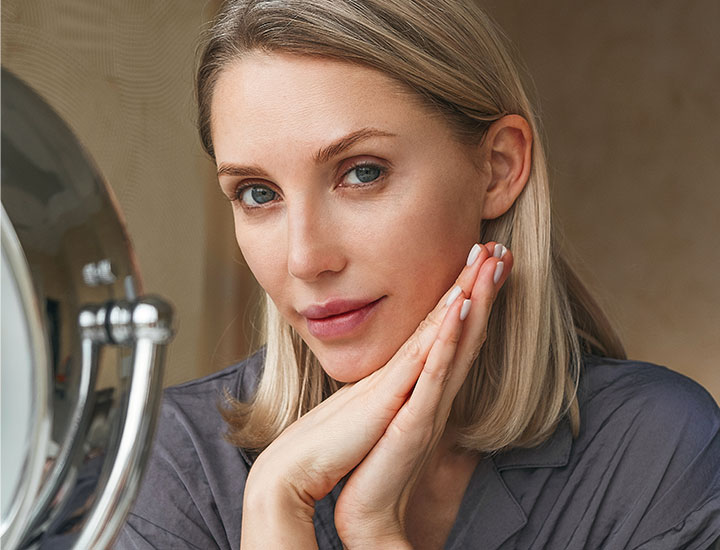Of all the skincare concerns that annoy you, sagging skin may be right up there at the top of the list. Pimples come and go. Even hyperpigmentation can be successfully addressed using topical ingredients and in-office laser procedures. But, as much as you massage your skin or attempt to tighten it with serums, sagging skin is a stubborn one with few solutions short of surgery.
As usual, prevention is the best cure when it comes to most skincare issues, including sagging skin. Valerie Aparovich, certified cosmetologist and aesthetician, who has a BS in Applied Biochemistry, and is a Science Team Lead at OnSkin, helps us tackle the very common skin concern that is sagging skin by pointing out the one common skincare mistake you could be making to cause it.
Mistake: Not Wearing Sunscreen Regularly
Brush you teeth, put on your socks and shoes, apply sunscreen — that last step should be as much a part of your routine as the first two — but you’re far from alone in forgetting to apply SPF every single day.
“Not protecting your skin from UV damage can drastically affect skin sagging, and overall, leads to photo-aging,” Aparovich says. And it’s not just sunny, hot summer days you should be concerned with. “A high UV index does not necessarily require bright sunshine as the rays can easily reach the earth’s surface through clouds. Also, window glass, if it’s not specifically toned against ultraviolet, does not protect your skin from sun exposure,” Aparovich adds.
It’s also important to understand how sunscreen works and why it’s important to re-apply it throughout the day. “Sunscreen works at its maximum within two hours after its application; after that, the effect decreases, so it should be reapplied,” Aparovich says. “Also, if you wear makeup, sunscreen should be applied underneath it. It means you must first remove the makeup to reapply the sunscreen. As it’s far from convenient, not many women do that, so the skin stays unprotected against the sun and suffers from its negative impact.”
As much of a hassle as it can be, sunscreen is a must if you want to maintain a youthful complexions. “Intense and frequent sun exposure results in the skin losing its elasticity, resilience, and firmness,” Aparovich says. “It gets over-dried, wrinkled, and saggy. And overall, more vulnerable to any adverse environmental stressors.”


How do UV rays cause sagging?
Let’s break this down even more to understand why SPF is a gold-standard product in skincare. “UV rays cause free radical damage over the skin, which leads to oxidative processes within the cells, evaporates moisture, and breaks down collagen fibers,” Aparovich explains. “Collagen, a fibrillar protein, is one of the main components of the body’s connective tissue, including the dermis – the layer of skin between the epidermis and fatty tissue. The dermis is responsible for the strength and elasticity of the skin, as well as its ability to stretch. When the volume of collagen decreases, the skin appears thinner, more flabby and loose, and prone to sagging.”

What other habits or factors can contribute to skin sagging?
While UV ray damage is way up there in culprits for sagging skin, there are a few more factors that could be contributing, Aparovich says:
Applying your cosmetic products against facial massage lines:
“All the moves you perform on your skin should be light, gentle, and sliding along facial massage lines – directions in which the skin is stretched the least, so it’s protected from deformation and sagging,” Aparovich says. “The moves should go from the central line (your nose and lips) towards your ears. Your fingers should move in slightly curved trajectories, going up. The skin must never go down as it leads to its overstretching and sagging over time.”
Staying in a vertical position when doing alginate masks:
“Alginate masks are very hydrating and nourishing, but are also rather heavy and bring muscle relaxation,” Aparovich says. “So, to be used safely, they should be worn and removed when you’re lying horizontally. Otherwise, it will force the skin to go down and contribute to its sagging.”

What are some topical and in-office treatments you recommend for sagging skin?
All of this advice is all well and good if you still have time to prevent sagging skin. But what can you do if you have some sagging now that you want to address?
Regular use of sunscreens: “It won’t improve sagginess but it will prevent the problem from rapid acceleration,” Aparovich says. “The creams with 50 sun protection factors, containing the combo of safe mineral (physical) and chemical filters, are an optimal solution.”
Topical cosmetic products won’t work wonders to improve skin elasticity from the inside out. Still, several ingredients are shown to promote collagen synthesis and provide deep hydration, so with regular use, the skin will appear thicker, firmer, and smoother, Aparovich explains. “Plant-derived antioxidants, and the ones contained in vitamins A, E, and C, can reduce the breakdown and enhance collagen production. Peptides help to repair damaged skin cells and trigger collagen production. The primary function of collagen itself in cosmetics is moisturizing, but if the product contains this ingredient in significant amounts, it may visually appear that sagging skin and wrinkles have improved.”
“Lymphatic drainage can help combat deformational changes,” Aparovich says. “It helps to boost lymph flow and eliminate lymph stagnation, bringing fluid levels in balance. Stagnation of lymphatic fluids leads to face puffiness and swelling that deformate face contours and increases face volume, making skin tissues heavier and causing stretching and sagging.”
RF-Lifting: “Among professional treatments, the most efficient one to combat skin sagging, based on my practice, is RF-Lifting (radio frequency lifting),” Aparovich says. “It’s a non-surgical skin rejuvenation and tightening method. Under the influence of high temperature, the collagen fibers (on which skin’s elasticity depends) begin to tighten, blood circulation and lymph outflow improves, and the production of collagen is stimulated.”
Mesotherapy and biorevitalization: “The dermis cells receive the missing essential substances thanks to the injection of the ‘cocktail’ of vitamins, minerals, and amino acids. As a result of course therapy, they accumulate in the skin, improving the structure of its tissues,” Aparovich says.
Microcurrent therapy: “This procedure is based on the use of low-voltage electricity that helps stimulate muscles, ATP (adenosine triphosphate) cell growth, and collagen production in the dermis. As a result of course therapy, skin appears more elastic and toned,” Aparovich says.
Remember: changes to the skin, including sagging, are normal. They happen to everyone. But, if they concern you, it's never too late to prevent new skin damage and treat the damage you may already have.


























